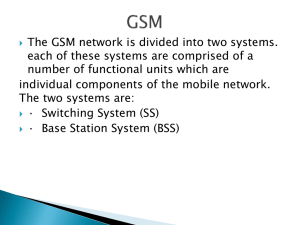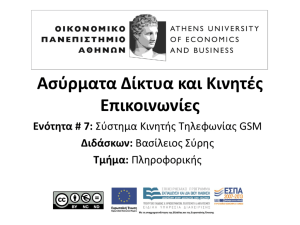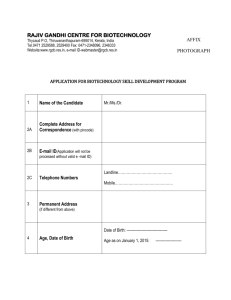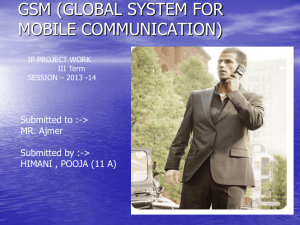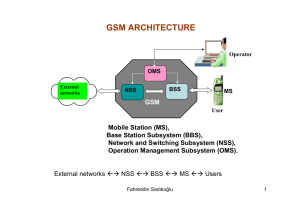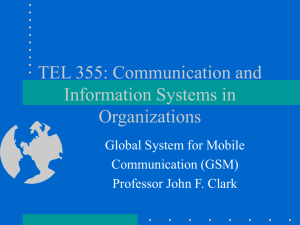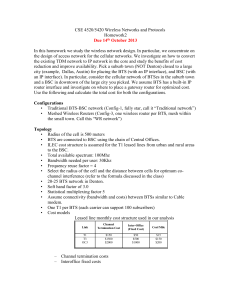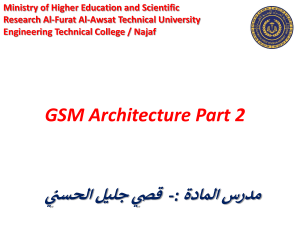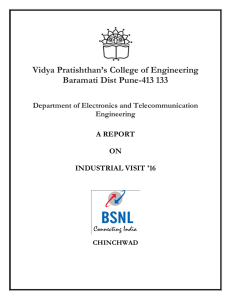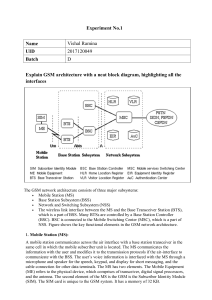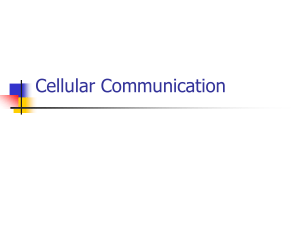GSM System Architecture
advertisement
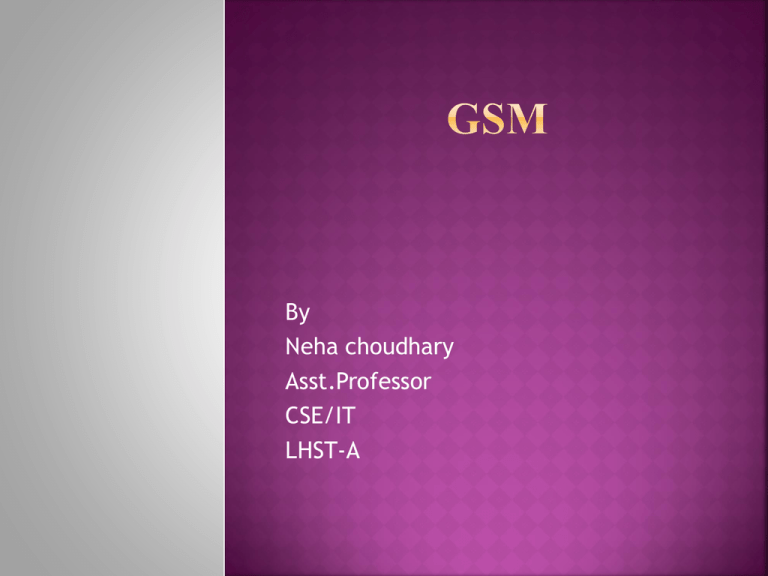
By Neha choudhary Asst.Professor CSE/IT LHST-A GSM-Introduction Architecture Technical Specifications Characteristics Applications and features Global System for Mobile (GSM) is a second generation cellular standard developed to cater voice services and data delivery using digital modulation Developed by Group Spéciale Mobile (founded 1982) which was an initiative of CEPT ( Conference of European Post and Telecommunication ) Aim : to replace the incompatible analog system Presently the responsibility of GSM standardization resides with special mobile group under ETSI ( European telecommunication Standards Institute ) Full set of specifications phase-I became available in 1990 Under ETSI, GSM is named as “ Global System for Mobile communication “ Tele-services Bearer or Data Services Supplementary services Telecommunication services that enable voice communication via mobile phones Offered services Mobile telephony Emergency calling Include various data services for information transfer between GSM and other networks like PSTN, ISDN etc at rates from 300 to 9600 bps Short Message Service (SMS) up to 160 character alphanumeric data transmission to/from the mobile terminal Unified Messaging Services(UMS) Group 3 fax Voice mailbox Electronic mail Call related services : • Call Waiting- Notification of an incoming call while on the handset • Call Hold- Put a caller on hold to take another call • Call Barring- All calls, outgoing calls, or incoming calls • Call Forwarding- Calls can be sent to various numbers defined by the user • Multi Party Call Conferencing - Link multiple calls together • CLIP – Caller line identification presentation • CLIR – Caller line identification restriction • CUG – Closed user group • http://www.arcx.com/sites/GsmFeatures.htm PSTN ISDN PDN BSC MS BTS MSC GMSC BTS BSC VLR MS EIR BTS AUC MS HLR Mobile Station (MS) Mobile Equipment (ME) Subscriber Identity Module (SIM) Base Station Subsystem (BSS) Base Transceiver Station (BTS) Base Station Controller (BSC) Network Switching Subsystem(NSS) Mobile Switching Center (MSC) Home Location Register (HLR) Visitor Location Register (VLR) Authentication Center (AUC) Equipment Identity Register (EIR) The Mobile Station is made up of two entities: Mobile Equipment (ME) Subscriber Identity Module (SIM) Mobile Equipment Portable,vehicle mounted, hand held device Uniquely identified by an IMEI (International Mobile Equipment Identity) Voice and data transmission Monitoring power and signal quality of surrounding cells for optimum handover Power level : 0.8W – 20 W 160 character long SMS Subscriber Identity Module (SIM) Smart card contains the International Mobile Subscriber Identity (IMSI) Allows user to send and receive calls and receive other subscribed services Protected by a password or PIN Can be moved from phone to phone – contains key information to activate the phone Base Station Subsystem is composed of two parts that communicate across the standardized Abis interface allowing operation between components made by different suppliers 1. Base Transceiver Station (BTS) Base Station Controller (BSC) 2. Base Transceiver Station (BTS): Encodes,encrypts,multiplexes,modulates and feeds the RF signals to the antenna. Frequency hopping Communicates with Mobile station and BSC Consists of Transceivers (TRX) units Base Station Controller (BSC) Manages Radio resources for BTS Assigns Frequency and time slots for all MS’s in its area Handles call set up Transcoding and rate adaptation functionality Handover for each MS Radio Power control It communicates with MSC and BTS Heart of the network Manages communication between GSM and other networks Call setup function and basic switching Call routing Billing information and collection Mobility management Registration Location Updating Inter BSS and inter MSC call handoff MSC does gateway function while its customer roams to other network by using HLR/VLR. Home Location Registers (HLR) permanent database about mobile subscribers in a large service area(generally one per GSM network operator) database contains IMSI,MSISDN,prepaid/postpaid,roaming restrictions, supplementary services. Visitor Location Registers (VLR) Temporary database which updates whenever new MS enters its area, by HLR database Controls those mobiles roaming in its area Reduces number of queries to HLR Database contains IMSI,TMSI,MSISDN,MSRN,Location Area, authentication key GSM 900 Mobile to BTS (uplink): 890-915 MHz BTS to Mobile(downlink):935-960 MHz Bandwidth : 2* 25 MHz GSM 1800 Mobile to BTS (uplink): 1710-1785 MHz BTS to Mobile(downlink) 1805-1880 Mhz Bandwidth : 2* 75 MHz Call Originating from MS Call termination to MS 1. 2. MS sends dialed number to BSS BSS sends dialed number to MSC 3,4 MSC checks VLR if MS is allowed the requested service. If so, MSC asks BSS to allocate resources for call. 5 MSC routes the call to GMSC 6 GMSC routes the call to local exchange of called user 7, 8, 9,10 Answer back(ring back) tone is routed from called user to MS via GMSC,MSC,BSS 1. Calling a GSM subscribers 2. Forwarding call to GSMC 3. Signal Setup to HLR 4. 5. Request MSRN from VLR 6. Forward responsible MSC to GMSC 7. Forward Call to current MSC 8. 9. Get current status of MS 10. 11. Paging of MS 12. 13. MS answers 14. 15. Security checks 16. 17. Set up connection Between 1 and 2 – Inter BTS / Intra BSC Between 1 and 3 – Inter BSC/ Intra MSC Between 1 and 4 – Inter MSC Fully digital system using 900,1800 MHz frequency band. TDMA over radio carriers(200 KHz carrier spacing. 8 full rate or 16 half rate TDMA channels per carrier. User/terminal authentication for fraud control. Encryption of speech and data transmission over the radio path. Full international roaming capability. Low speed data services (upto 9.6 Kb/s). Compatibility with ISDN. Support of Short Message Service (SMS). Mobile telephony GSM-R Telemetry System - Fleet management - Automatic meter reading - Toll Collection - Remote control and fault reporting of DG sets Value Added Services Thanks !
